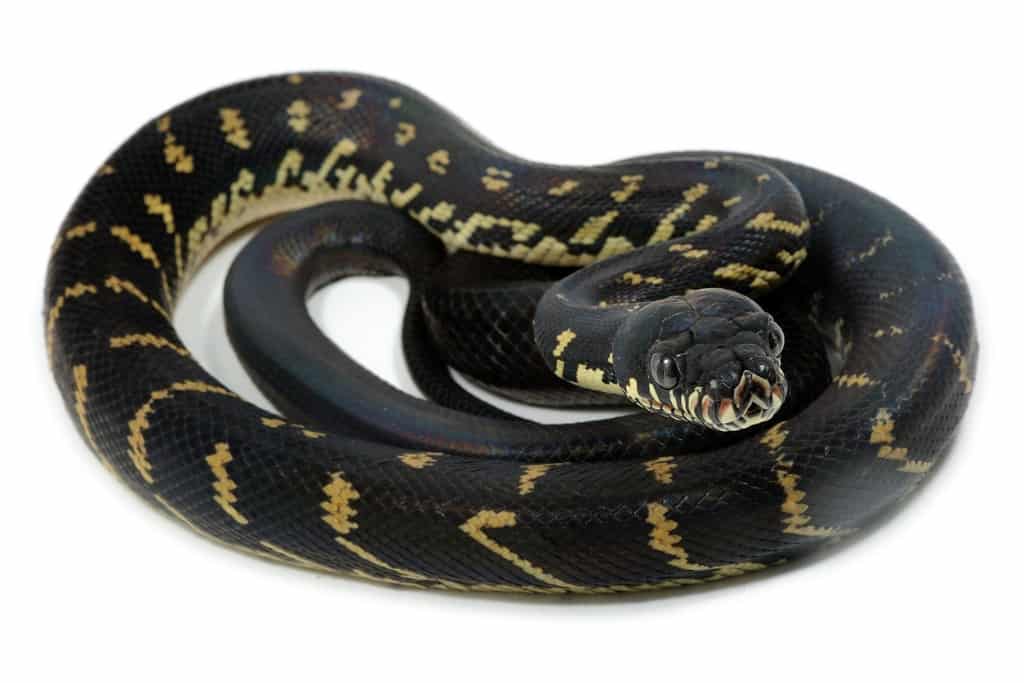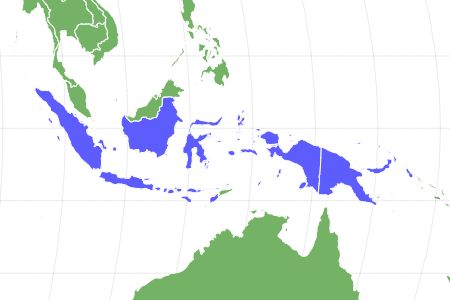Boelen’s python
Simalia boeleni
A single hatchling can go for over $5,000 as a pet.
Advertisement
Boelen’s python Scientific Classification
- Kingdom
- Animalia
- Phylum
- Chordata
- Class
- Reptilia
- Order
- Squamata
- Family
- Pythonidae
- Genus
- Simalia
- Scientific Name
- Simalia boeleni
Read our Complete Guide to Classification of Animals.
Boelen’s python Conservation Status
Boelen’s python Facts
- Prey
- Cuscus, rodents, bats, lizards, frogs
- Main Prey
- Rodents and cuscus
- Name Of Young
- hatchling
- Group Behavior
- Solitary
- Solitary except during mating season
- Fun Fact
- A single hatchling can go for over $5,000 as a pet.
- Estimated Population Size
- Unknown
- Biggest Threat
- Over harvesting for pets
- Most Distinctive Feature
- iridescent black scales and pale chin and jaw
- Other Name(s)
- Bulinee, Ular hitam, Sanca bulan, Hitam wallow, Wabir wallow, Wallao kaliye, papa graun moran, blu moran, papua sanca moon
- Litter Size
- 4-15
- Diet
- Omnivore
- Lifestyle
- Diurnal
Boelen’s python Physical Characteristics
- Color
- Yellow
- Black
- White
- Skin Type
- Scales
- Lifespan
- 15-20 years
- Length
- Up to 14 feet long
- Age of Sexual Maturity
- About 2 years old
- Venomous
- No
- Aggression
- Low
View all of the Boelen’s python images!
Boelen’s python is a native of New Guinea that is still a bit of a mystery to science.
This species only lives in the highland mountains that run through central New Guinea. It is a diurnal predator that spends most of its time on the ground hunting. There are reports of a few snakes reaching 13-14 feet long, but most often it averages about eight feet long.
4 Amazing Facts About the Boelen’s Python
- This snake experiences an ontogenic color shift. That is, it hatches one color (reddish-orange or red) and then changes to another (black) as it matures.
- It figures in the mythology and culture of some of the tribes in New Guinea.
- Boelen’s python inhabits such a remote area that it was only discovered by western science in 1953.
- A single hatchling can cost over $11,000 and they’re very difficult to breed in captivity.
Where to find Boelen’s Python
You’ll find this python at elevations of 7,500 to 8,500 feet in the mid-mountain forests of New Guinea in the Jayawijaya Mountain range. Occasionally, there’s a report of one in areas anywhere from the Bird’s Head Peninsula to Goodenough Island, but the temperatures in those areas aren’t optimal for the pythons.
This species is somewhat timid and hard to observe, let alone find in the wild. The mountainous region that it calls home is remote and isolated. Any useable roads are usually maintained by private companies that mine for resources like gold and other precious metals; they’re not available to the public. Yet, the publicly accessible roads aren’t passable except with a well-equipped SUV. This, along with its newness to western science, adds up to a snake that is, in some ways, still very much a mystery and difficult to study.
Boelen’s python is a terrestrial species, most active during the day. In the wild, their diet consists of lizards, frogs, cuscus, bats, and rodents. In captivity, they will take rats, quail, and rabbits. Most of what we know about their behavior and breeding comes from herpetoculturists who keep them as pets and zoos that are working to breed them.
Scientific Name and Classification
Boelen’s python is named after K.W.J. Boelen, who helped obtain specimens of the species for scientists to study. In 1953, when it was first described, scientists classified it as Liasis boelini; in 1958 it moved to Liasis toranga; over the years, it’s been variously classified in the genera Morelia, Simalia, Liasis, and Lenhoserus, finally landing (thus far), in the Simalia genus, with the Amethystine python and a few others.
Simalia genus pythons occur in Indonesia, Papua New Guinea, and Australia. Members of this genus are generally pretty big, and there are reports of Boelen’s pythons growing up to 14 feet long.
This snake goes by several names, including black python; locals know it by blue moran, papa graun, and a few others, but that depends upon the language spoken at the time. On a large island with dozens of languages, it’s easy to see how a snake with sometimes mythical connotations can have several names.
Boelen’s Python Population and Conservation
While more research is needed, these beautiful snakes are well known to the local tribes and there are many beliefs surrounding them. The IUCN Redlist of Threatened Species considers Boelen’s python “data deficient.” There isn’t enough information on its population or rarity to make an accurate assessment.
This species is relatively unknown to science and was only discovered by the west in 1953. Boelen’s python doesn’t appear common in its native range, and a distinct lack of scientific data on its population, reproduction in the wild, diet, etc. That said, it doesn’t seem to reproduce in large numbers, so any take from the wild population can damage its numbers.
Western Guinea is part of Indonesia, and the protections offered by the government for this (and other) species are extremely limited. However, on the eastern half of the island is Papua New Guinea; it is strongly protective of its wildlife, including Boelen’s python. As a result, Papua New Guinea prohibits the export of most of its wildlife. In this, Papua New Guinea is similar to Australia.
Identifying the Boelen’s Python: Appearance and Description
Once you’ve seen a Boelen’s python, it’s unmistakable. It’s a large, muscular python with a big head and elliptical pupils; adults average about eight feet long. Mature individuals have a white to pale yellow belly color, which extends in streaks up their sides. Their backs are dark purplish- or bluish-black with a distinct iridescent, oil-slick-like sheen to their scales. Adults and juvenile snakes’ upper and lower jaws have alternating black (adults) or red (juveniles) and white to cream-colored vertical bars. Their nostrils and heat-sensing pits are large and noticeable.
Breeders and zoos are responsible for much of what we know about Boelen’s python and their breeding. Like all pythons, they lay eggs – the female will lay between 6 and 14 in a clutch, then coil around them while they develop. She protects the eggs until they hatch, about 70 days later. At that point, the babies are on their own.
Juveniles are a snake of another color. They hatch as a bright red or reddish-orange snake, then darken as they mature, becoming the striking black and white or yellow snake that we know as an adult Boelen’s python. Hatchlings measure about two feet long and reportedly have a very healthy appetite.
In captivity, Boelen’s pythons can live for 20 years and more, but no one knows how long they live in the wild. Again, we need more research to determine many aspects of their life cycle.

These snakes have distinct markings that make them easy to identify.
©iStock.com/reptiles4all
Pictures and Videos of the Boelen Python

Hatchlings are bright red; they darken as they mature.
©iStock.com/reptiles4all

This species is native to New Guinea and they are protected in Papua New Guinea, but not Indonesia.
©iStock.com/Florian DENIS
How Dangerous are Boelen’s Pythons
They’re not venomous, but Boelen’s pythons can grow rather large – about 8 feet long with some reports of individuals reaching 14 feet long. Their muscular body makes them capable of injuring a person by constriction; however, they aren’t an aggressive species.
Boelen’s Python Behavior and Humans
This reclusive snake is part of the regular diet of some tribes. Other tribes only allow their warriors to eat it, and only when getting ready for war because they believe it to be one of their gods. They believe that eating Boelen’s python before going into war may give them special powers.
The snake figures heavily in the mythology of several tribes. In one story, a god that had beautiful feathers ran from a fight. As he ran, he shed the feathers bit by bit until all that remained was a black python with iridescent scales.
On the Indonesian side of New Guinea, a vibrant pet trade exports many native animals, including Boelen’s python. One problem with this is that wild-caught snakes often do not survive captivity. Additionally, those that survive in captivity often refuse to breed. Very few breeders have managed to get these snakes to breed, and those command high prices for one hatchling, currently $11,000 and up.
The other problem is the risk of over-harvesting. Some species were driven to extinction in the wild by over-harvesting – whether for the pet trade or other purposes.
Similar Animals
- Pygmy Pythons are the opposite of Boelen’s pythons, they’re downright dainty in comparison.
- Woma Pythons include venomous snakes in their daily diet and are immune to most of their venom.
- Amethystine pythons are close cousins and have an iridescent sheen reminiscent of an amethyst gemstone.
Boelen’s python FAQs (Frequently Asked Questions)
Are Boelen's pythons venomous?
No, they’re a species of nonvenomous python, cousins to reticulated pythons, ball pythons, and others.
How do Boelen's pythons hunt?
There’s not much data on their behavior. They’re diurnal, and scientists assume that they’re primarily an ambush predator, like other pythons.
Are Boelen's pythons aggressive?
No, these are very docile pythons. Wild-caught individuals may be more snappy than captive-bred, but in general they’re mild-mannered.
Where do Boelen's pythons live?
These reclusive snakes live in the remote highlands of New Guinea.
What do Boelen's pythons eat?
They eat a variety of small prey which includes cuscus, rodents, bats, lizards, and frogs.
Thank you for reading! Have some feedback for us? Contact the AZ Animals editorial team.
Sources
- Black Python | IUCN Redlist of Threatened Species, Available here: https://www.iucnredlist.org/species/42494046/42494055
- Simalia boeleni | Reptile Database, Available here: https://reptile-database.reptarium.cz/species?genus=Simalia&species=boeleni
- Morelia boeleni | Encyclopedia of Life, hosted by the National Museum of Natural History, Available here: https://eol.org/pages/458601
- Boelen's Reptile | Everything Reptiles, Available here: https://www.everythingreptiles.com/boelens-python/
- Boelen's Python | St. Louis Zoo, Available here: https://www.stlzoo.org/animals/abouttheanimals/reptiles/snakes/boelenspython
- Conservation Genetics of Boelen's Python (M. boeleni) from New Guinea: Reduced genetic diversity and divergence of captive and wild animals; Austin, Christopher C., Marc Spataro, et al , Available here: https://www.museum.lsu.edu/Austin/PDFs%20Austin/37.%20AustinetalConGen2010.pdf
- Threats to Boelen's Python | Mark O'Shea, Available here: http://www.markoshea.info/downloads/oshea_boelens_python.pdf

















